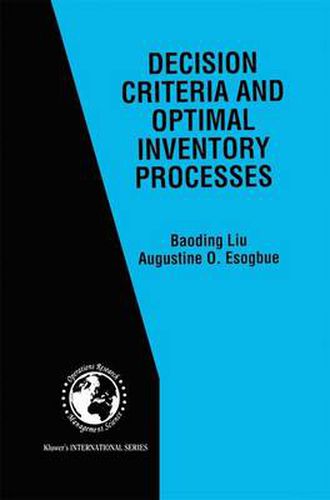Readings Newsletter
Become a Readings Member to make your shopping experience even easier.
Sign in or sign up for free!
You’re not far away from qualifying for FREE standard shipping within Australia
You’ve qualified for FREE standard shipping within Australia
The cart is loading…






This title is printed to order. This book may have been self-published. If so, we cannot guarantee the quality of the content. In the main most books will have gone through the editing process however some may not. We therefore suggest that you be aware of this before ordering this book. If in doubt check either the author or publisher’s details as we are unable to accept any returns unless they are faulty. Please contact us if you have any questions.
Decision Criteria and Optimal Inventory Processes provides a theoretical and practical introduction to decision criteria and inventory processes. Inventory theory is presented by focusing on the analysis and processes underlying decision criteria. Included are many state-of-the-art criterion models as background material. These models are extended to the authors’ newly developed fuzzy criterion models which constitute a general framework for the study of stochastic inventory models with special focus on the real world inventory theoretic reservoir operations problems. The applications of fuzzy criterion dynamic programming models are illustrated by reservoir operations including the integrated network of reservoir operation and the open inventory network problems.
An interesting feature of this book is the special attention it pays to the analysis of some theoretical and applied aspects of fuzzy criteria and dynamic fuzzy criterion models, thus opening up a new way of injecting the much-needed type of non-cost, intuitive, and easy-to-use methods into multi-stage inventory processes. This is accomplished by constructing and optimizing the fuzzy criterion models developed for inventory processes.
Practitioners in operations research, management science, and engineering will find numerous new ideas and strategies for modeling real world multi- stage inventory problems, and researchers and applied mathematicians will find this work a stimulating and useful reference.
$9.00 standard shipping within Australia
FREE standard shipping within Australia for orders over $100.00
Express & International shipping calculated at checkout
This title is printed to order. This book may have been self-published. If so, we cannot guarantee the quality of the content. In the main most books will have gone through the editing process however some may not. We therefore suggest that you be aware of this before ordering this book. If in doubt check either the author or publisher’s details as we are unable to accept any returns unless they are faulty. Please contact us if you have any questions.
Decision Criteria and Optimal Inventory Processes provides a theoretical and practical introduction to decision criteria and inventory processes. Inventory theory is presented by focusing on the analysis and processes underlying decision criteria. Included are many state-of-the-art criterion models as background material. These models are extended to the authors’ newly developed fuzzy criterion models which constitute a general framework for the study of stochastic inventory models with special focus on the real world inventory theoretic reservoir operations problems. The applications of fuzzy criterion dynamic programming models are illustrated by reservoir operations including the integrated network of reservoir operation and the open inventory network problems.
An interesting feature of this book is the special attention it pays to the analysis of some theoretical and applied aspects of fuzzy criteria and dynamic fuzzy criterion models, thus opening up a new way of injecting the much-needed type of non-cost, intuitive, and easy-to-use methods into multi-stage inventory processes. This is accomplished by constructing and optimizing the fuzzy criterion models developed for inventory processes.
Practitioners in operations research, management science, and engineering will find numerous new ideas and strategies for modeling real world multi- stage inventory problems, and researchers and applied mathematicians will find this work a stimulating and useful reference.